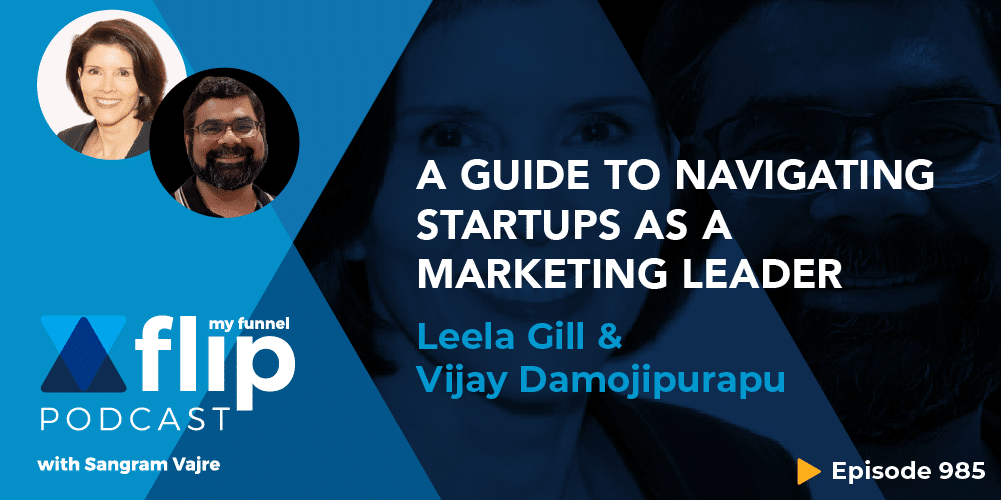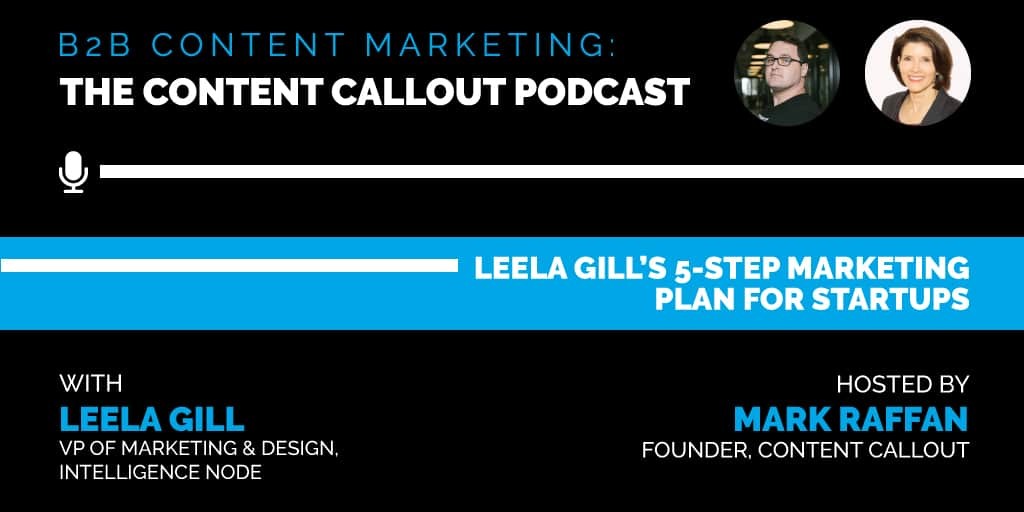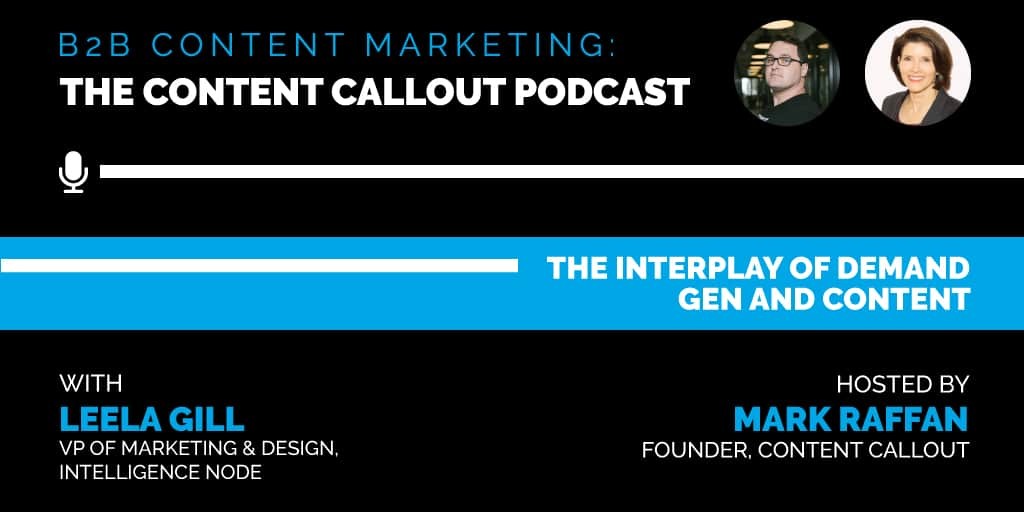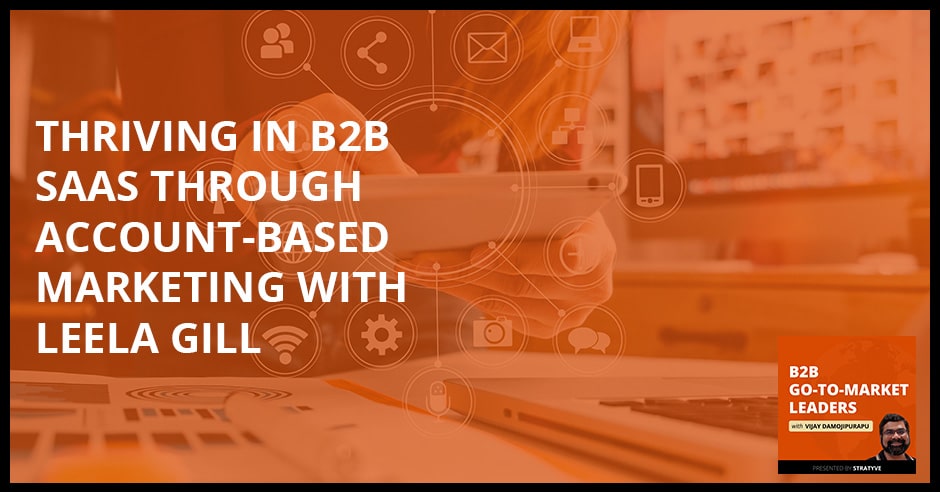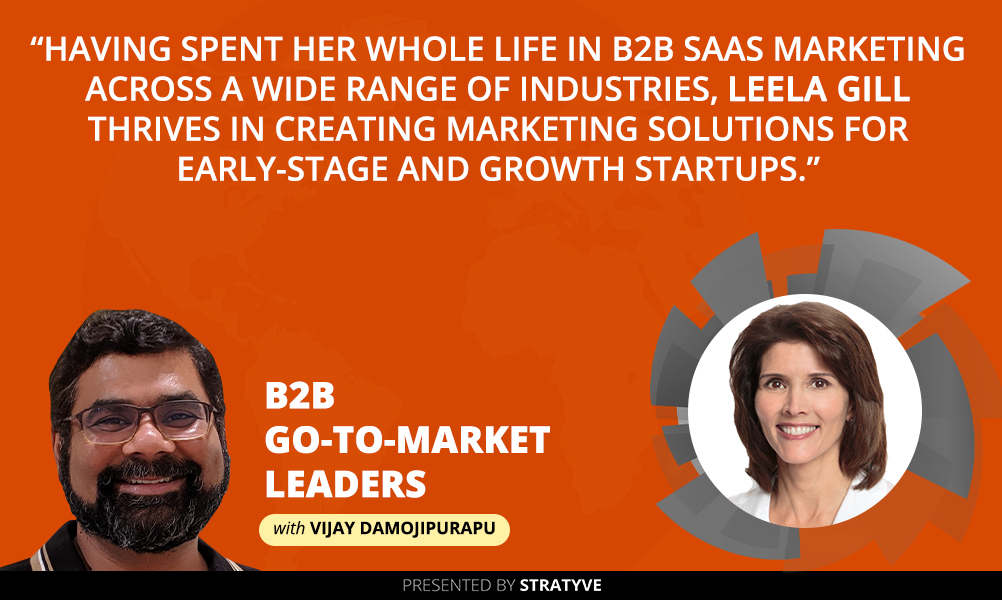Early-Stage Marketing: A Five-Point Leadership Framework
It is estimated that over a million tech startups are formed every year globally. And, according to an article on TechCrunch, about 60% of startups don’t make it to Series A and even less make it to Series B and beyond. The takeaway? Early-stage companies are like a swimming frenzy of baby sea turtles — survival is rough and the odds are tough.
For those of us who play in this world, we feel that pressure every day. Early-stage marketing leaders are in the hot seat. Some might say it is the penultimate driving force for creativity. We must create something from nothing to survive and then help it grow, fast.
We all know that startup companies are fast-paced and experimental by nature — the antithesis of the process-oriented and predictable large enterprise. However, implementing a few repeatable strategic business practices can help Series A and B teams navigate the ready-fire-aim environment with purpose. It’s true that there is no silver bullet, but this five-point leadership framework can help marketing leaders reach the next stage of development.
1. Audit where you are every quarter.
One of the most important priorities for early-stage marketing leaders is to develop a clearly defined ideal customer profile (ICP), as this can mean the difference between effective campaigns and ones that fail. One of the first habits to form is auditing your closed-won deals every quarter and mapping the top five to 10 attributes that made them an ICP for your business. Then, look at your sales qualification criteria and determine if you are asking the right questions to generate viable leads. If not, revise and retrain your teams.
Growth marketers should also audit:
• The buyer persona: Have you correctly characterized the person within the ICP to whom you want to sell? It is very likely that your ICP and personas will change over time, so this auditing process will help you adjust quickly when needed.
• Brand promise: Has it been established, and are you sticking to it?
• Value proposition: Do your ICP and personas agree with your company’s value proposition? When you talk to your customers, are you using the words they use when they describe the benefits of your solution?
• Customer relationship management (CRM): Are you keeping your data clean and segmented so you can communicate effectively with prospects?
• Collateral: Does your collateral cover the fundamental content needs, including proper sales messaging, product sheets, brand and product videos, best practice e-books and SEO blog posts?
2. Focus your budget on conversion and pipeline growth.
It’s tempting to want to do it all — brand, demand, fancy tech stack, PR, AR and more — but at this stage, your marketing budget needs to be allocated to generating qualified leads for your sales team. Period. Focus your dollars on activities like paid advertising, events and content that converts.
What should your budget be? According to a recent SaaS-Capital benchmark report, early-stage SaaS companies can spend approximately 15% of annual recurring revenue (ARR) on marketing. So, if your ARR is $5M, you can expect a marketing budget of around $750K, of which approximately 45% to 50% should be spent on headcount and the remainder allocated to programs.
And according to one article, if you are well-funded, your customer acquisition cost (your total sales and marketing cost divided by the number of closed deals) can be up to 50% of your first-year average contract value.
3. Quantify team strengths, hire for the gaps and upskill constantly.
In the beginning, you will hire one or two marketers. This team must be versatile and capable of managing multiple components of marketing all at once, including content, demand generation and search engine marketing (SEM) basics. Don’t make the mistake of hiring junior people; you need team members who can run programs without much assistance.
When you get to Series B, you should have the core marketing skill sets on board: product marketing, marketing operations, content SME, demand gen, digital and creative. If you are missing any of these core skills, you should fill the gaps with an agency or upskill your team.
To grow, you need to honestly assess your team’s strengths. Take the time to create a quarterly performance process that includes a skills audit and builds in upskilling and learning as part of your marketing culture.
4. Align around product strategy.
To create focus and speed, align your marketing events around the product road map and push for new product events every quarter. This operating model, also known as “the cadence methodology,” was developed by venture capitalist and former Yammer CEO David Sacks. This model works because the whole company focuses on product innovation. Then, it is marketing’s job to promote the new features every quarter via event marketing.
5. Take aim at your exit criteria.
In the B round, revenue expectations are high and forgiveness is scarce. As a marketing leader, you need to grow while keeping your eye on your exit criteria: Series C funding. Here is my punch list to ensure you get to the next funding round:
• A clear definition of your target market, ICP and persona.
• A documented and proven brand promise and value proposition.
• Alignment and broad communication of the go-to-market strategy from senior leadership.
• Excellent sales and marketing alignment around process and tech stack.
• Knowledge of the most effective marketing channels.
• A quarterly business cadence and reporting framework.
• Documentation of your key processes (to scale).
• Customers who talk about your products positively and often.
• Hitting your revenue growth goals.
As early-stage marketing leaders, we face a myriad of challenges, but a strong leadership framework — one that centers around building good habits and processes early — can exponentially increase your chances of receiving Series C funding and beyond.
Related Posts:
Influencers, Brand Ambassadors and Raving Fans – and Why You Need All Three
For marketers, influencers, brand ambassadors, and raving fans can create a significant differentiator…
Marketing as a Revenue Generator and Catalyst for Change
Marketing is a change catalyst, calling customers to change and jump on, and it also helps the organization…
A Guide To Navigating Startups as a Marketing Leader
It can’t be understated: Being a marketing leader of a startup can be crazy and chaotic. Out of the million…
A 5-Step Marketing Plan for Startups
As a marketing professional working in a startup, do you know how to help your company grow revenue? How is…
Building A Diverse And Equitable Business: The Role Of Marketing
Jesse Jackson once said, “Inclusion is not a matter of political correctness. It is the key to growth.” This…
B2B Marketing: What We Can Do To Help Save The Planet
The COVID-19 pandemic is the biggest business challenge of a generation. Organizations scramble to establish…
The Interplay of Demand Gen and Content with Leela Gill
The COVID-19 pandemic is the biggest business challenge of a generation. Organizations scramble to establish…
Early-Stage Marketing: A Five-Point Leadership Framework
The COVID-19 pandemic is the biggest business challenge of a generation. Organizations scramble to establish…
Social Media: Getting Above the Noise
The COVID-19 pandemic is the biggest business challenge of a generation. Organizations scramble to establish…
Thriving In B2B SaaS Through Account-Based Marketing With Leela Gill
SEO and other full-funnel strategies may get you the most leads, but a more targeted approach in marketing is needed if you’re looking to catch the big fish. When it comes to targeted approaches, account-based marketing trumps everything else. Leela Gill, the VP of Marketing at Intelligence Node, specializes in this space and has a track record of delivering this strategy in the B2B SaaS marketing space. For her, account-based marketing is simply Marketing 101. Listen in as she joins Vijay Damojipurapu on the show to explain how this strategy works and how she engages her marketing team at Intelligence Node to deliver the best results at a faster rate.
Thriving In B2B SaaS Through Account-Based Marketing With Leela Gill
In this episode, I have Leela Gill. She is the VP of Marketing at Intelligence Node. She’s got a solid track record of diverse experiences across sales and marketing and leading those functions at startups. Leela’s main expertise and track record is around account-based marketing and selling to big brands like Walmart, Home Depot, Lockheed Martin. Leela, I also looked up your background. It seems like you got some good exposure and experience in M&A, change management and fundraising. A lot of topics and a lot of ground for us to cover here. Welcome, Leela.
Thank you. I’m happy to be here, Vijay.
The first question I have for all my guests is how do you define go-to-market?
I define go-to-market as the approach that you’re going to take with your marketing sales and channel partners to deliver your unique value proposition to prospects and customers. There are multiple approaches and multiple activities around go-to-market strategies. You have a go-to-market strategy for your corporation or your business, and you should have a go-to-market strategy for product launches. The ways that you approach marketing sales and channel partner sales in selling to your prospects and to your customers are the go-to-market approach.
It’s funny you say that. I agree with both views of the go-to-market. Early on in my career, I was more in the product marketing track. My view of the go-to-market was the upcoming launch for the product and that’s about it. Line up and essentially worked closely with the product, with other teams within marketing, with sales and sales enablement, even customer support and customer success teams. That is my view of go-to-market back then. Since then, I have evolved my thinking. That leads to the first point which you mentioned that it is not about the upcoming product launch, but it goes much and far beyond that.
I work with early-stage and growth companies. You do have to step back and think about your go-to-market from a company perspective. Where do you fit into the category? Are you creating a new category? What’s the ideal customer profile that you’re going after the persona and all those elements that go into a GTM strategy?
You mentioned a couple of things. One is the personas and the ideal customer profile. You’re also looking at the buyer’s journey, not just the seller’s or sales’ journey. How often typically do you do that or would you push your teams to do an update to the personas?
First, I want to back up and explain what I do as foundational work with my go-to-market strategy. There’s some foundation work that needs to be done around your vision and your mission. I believe it’s important to develop a purpose-driven organization so that inspires people. A lot of people don’t recognize this, but we make decisions emotionally. We use the logical side of our brain, the left side of our brain to justify those emotional decisions. We come up with the ROI. Having a purpose-driven organization with a vision and a mission that resonates with human beings is super important. On top of that foundation is honing in on your ideal customer profiles and your personas. That’s the foundational work and then developing the strategic messaging architecture on top of that. Beyond that, understanding where you are relative to your competition, and then you get into the more micro details around pricing strategy and sales and marketing alignment.

Your approach is completely validated by the market leaders out there, which is you need to lay out all those foundation elements and then continuously assess what pieces do you need to change or update. Do you do that on a quarterly basis or annual basis? I’ve seen it fall in all ends.
Going back to your point about timing, we set the strategy on an annual basis, but we have a quarterly cadence that we put into play that allows us to do a check step, a continuous improvement step. We don’t necessarily go restructure the foundation, the mission, the vision and the foundational work. We don’t redo that. As an early-stage company, you do have to check that and refine, especially on the personas because if you’re going in and you don’t understand your personas well, then you need to be constantly going out there and talking to them and understanding what their pain points are and what drives their decision-making. With that said, we put a strategy together for the year, and then we certainly check steps in a quarterly cadence.
The go-to-market topic and the various topics around it are so diverse. We easily got pulled early in this conversation. Let’s step back a bit, Leela. For the audience, can you share a bit about your personal journey as well as your professional milestones? What do you do at Intelligence Node and what your focus areas are?
I turned marketing operations professional and leader after school. My first job out of school was with a multi-billion-dollar engineering company. I started out in engineering, and then ended up running a very large manufacturing plant. That’s a whole other episode on the first woman that runs a multimillion-dollar manufacturing plant for this company. Beyond that, what I like to tell people is that I’ve spent my whole adult life doing B2B SaaS marketing. My background is I’ve sold into the FinTech sector, the green tech sector, the retail tech sector, and the HR tech sector. It is a wide range of industries in all B2B SaaS marketing. I thrive with early-stage and growth companies. That’s where I get excited because there’s a real creative process there that has to happen. You also have to be courageous. Those are two of my core values, being creative and courageous. In those growth companies, there are lots of highs and lows and I liked that excitement.
Would you say that your core values as creative and courageous are what pulled you or shifted your journey from manufacturing engineering to early-stage B2B marketing?
Yes. Both of my parents were engineers, so I felt like I was destined to go on that path. Later in my life, I realized I’m more on the frontend of the business. I like interacting. I love working with the sales team. I love being in front of people and understanding them. I jumped over to that side of the road. Beyond my work profile, I live in San Francisco. I am a mother of two teenagers and my husband is completely opposite of me. He’s a social worker in the nonprofit world. I work in a for-profit world. He does a lot of amazing work for our communities. I’m very active in my community as well as a leader.
That’s a way to lead a more meaningful and purposeful life. It is not about work or making money, but contributing the society as a whole. I was trying to hit a point earlier, which is you realize that rather than you living a life defined by your parents, where they are engineers and you by default went into engineering, slowly over time, you realized, “That’s their life. If I’m doing engineering, I am living their version of my life versus my version of my life.”
I think back to when I was growing up, that’s what a lot of kids or young people did. I am happy about this generation of young people that are coming up because I don’t think they follow the same ground rules. They’re searching now for what’s important to them. They’re vocalizing the importance of particular things in our economy and our culture that are important. I’m delighted that the young people are coming into their own quicker and taking their power seriously while they have the ability to influence.
While on the topic of young people, how do you describe what you do at work to your kids? With those teenagers, they get a sense of what you do.
I do test my children to find out if they know what my title is. They do know my title. They do know that I work in marketing for a software company in the retail industry so I would check those boxes. I think that’s good, but I am digging into it. I don’t know that they understand what marketing is. The older one is in college. He’s starting to learn what marketing is so we have some fun conversations about that.
I continue to have these conversations with my kids as well, two boys. I educate them on what marketing is in their own terminology. Back in the days when Toys “R” Us was still around, I used to portray that as marketers do the stuff, which pulls you into getting your parents to buy the toys for you.
That’s a good description. That’s a great age group too. I love that age.
Building on our earlier questions around go-to-market and how you define go-to-market, back at Intelligence Node, you got a diverse set of responsibilities all the way from account-based marketing to field marketing, content, thought leadership and brand. What is your top 2 or 3 key go-to-market programs? How do you build your teams and give them direction in executing those?
There’s a lot packed into that question. I’ll start with our key programs. We have done a good job on organic SEO work. Before I came into the company, we got a lot of our leads through SEO and organic search, which was great. We continue to use that as the main strategy. We’ve also built on top of that an account-based marketing approach. My favorite quote or saying out there is, “Account-based marketing is a good marketing.” I do believe that. Account-based marketing makes you focus on who you’re trying to sell to, what is the value proposition, what are their pain points, and getting that messaging honed in. There’s also an element of timing. You’ve got to get in front of the right people at the right time and have a message that resonates with them. It sounds easy enough to describe, but it is tougher than you think, especially the timing element.
I think you hit it well. That’s what I used to wonder when this whole account-based marketing terminology and phrase started getting popular in the marketing world and even beyond years ago. As time went by, I started wondering, is this a new paradigm? If you deep dive below that acronym, it’s all about how do you understand your target people, customers and individuals? How do you understand them as human beings? What drives them and how do you get in front of them on an ongoing, but in a healthy manner? How do you stay in touch with them, and then help them see the value of what you do? If you peel that onion and go up level, it’s Marketing 101, nothing different.
It’s good marketing. For somebody, with my background in engineering, I like learning, digging in, getting data and understanding specifically who I’m selling to. I think that’s fun. Sometimes it’s hard, especially when you’re in growth companies, to take that time and to understand who your target market and your personas. If there’s any advice I’d give to people, it’s to make sure you understand your target market and your ideal personas because that is foundational work right there.

You also mentioned a couple of interesting nuggets over there, which is you do both inbound SEO, as well as account-based marketing. It’s two ends of the spectrum where typically inbound SEO, depending on our target market and customer base, is smaller sales cycles, smaller ACV account, Annual Contract Value or Annual Customer Value. That’s on one end of the spectrum. You’ve got the account-based marketing on the other end, which is more of longer sales cycles, bigger contracts, and longer-term commitments. How do you balance or what focus areas do you do? Is that an evolution that’s happened during the time? Are you shifting your market?
We are intentionally trying to shift to large enterprises more. We’re complementing our SEO strategy with targeted advertising using LinkedIn and Google retargeting ads to try to hone in on large enterprise. It’s true that SEO does bring in the smaller, mid-market companies for the most part. At least that’s been our experience. The mid-market is coming from the SEO leads that we’re finding people are searching for us and finding us. To complement that, we are doing a lot of work on LinkedIn and doing targeted advertising, targeted email campaigns, coming up with a target list of accounts, and reviewing that with our sales team, and making sure we’re aligned. We have in our tech stack of content delivery platform that personalizes to the company that’s coming in, adds a logo, adds the company name, does some text changes around that particular mission. We complement the SEO approach with this targeted marketing approach.
You mentioned one of the best practices, which I keep sharing with my clients. If you’re shifting to more account-based marketing, you also need to keep in mind the tech stack. For the benefit of the audience, would you mind sharing the details of the tech stack?
It starts with HubSpot. We’ve made a strategic decision. We were on HubSpot and Salesforce. For our company where we are in the cycle, we decided to migrate everybody over to HubSpot. It’s more intuitive. We don’t have a super large sales team, so it was the right tool. That was one of the most important decisions we’ve made because the syncing between HubSpot and Salesforce can cause issues. We are on HubSpot as our marketing automation and CRM tool. On top of that, we are using some tools for lead enrichment, Seamless.ai and LeadGenius. We use those two in different cases for those lead enrichment tools. Before that, we have intent data, which is critical. We’re using Bombora for intent data. On top of that, we’re using a content delivery platform called Folloze.com, which does the personalization on smart boards. That’s our tech stack. We have a lot of tools around that like SEMrush for SEO. We have lots of other little tools. We’re using some tools for conversion within LinkedIn. We’ve got a chatbot and some other tools around that as well.
It is great to push your team around constantly testing with a channel, doing several experiments around personalization, A/B testing and so on.
HubSpot is great because it allows you to do that A/B testing on your emails. They’ve also launched a target accounts module so you can identify your target accounts in HubSpot. You can hone in on whether how long they’re on your website. It gives you a little bit more focus on that account-based marketing program that you’re implementing.
Building on top of the tech stack as well as the account-based marketing, you also are a committed person in thought leadership. That’s something that I’ve seen where you publish on Forbes and several other industry publications. What are your thoughts if someone wants to build a thought leadership program? What is your advice and what did you tell them?
Thought leadership is about brand development.
Would you say both brand development for the company as well as brand development for an individual? They go hand-in-hand.
It depends on what you’re talking about. In one case, it might be about your products in the marketplace. With Intelligence Node, for example, we sell to retailers and brands. We talk about how we help them convert shoppers into buyers through the eCommerce buying journey. We have specific points that we interact with shoppers. We help retailers and brands become visible to shoppers and help them convert to buyers. We did a huge consumer buying behavior survey. It was a compilation of a lot of surveys that we started before COVID. We were doing the surveys consistently through COVID and we launched that report. We did a lot of thought leadership around that particular report because it’s a 40-page report packed with data.
We were doing podcasts, posts on social media, lots of email campaigns, and presenting at virtual round tables. That piece around, what are the consumers thinking now? You can’t do thought leadership unless you have a good topic that’s interesting to other people. From a company standpoint, you want to find what that information is. Present it in a way that’s easy to understand through multiple channels, and go into thought leadership with the idea that you want to educate. Thought leadership is not about selling. It’s about helping them understand. The same principles apply on a personal level.
That’s key, the points that you hit over there, which is it’s not about you trying to push a message or sell. It’s all about how you’re educating and showing the path forward and shifting their thinking. Are there ways in how you measure? I don’t know if there’s a way to measure thought leadership. I have not seen one. What is your view on that?
We measure it through share of voice, which is a metric that you can get. There are tools or PR firms out there that help measure it. It’s how many times you’re published or you’re out there in the media. We’re using their other metrics, but that’s the metric that we use mostly. Impressions, how many eyeballs did you get, those are the starting point. On top of that, the share of voice and engagement are important measures. On your social media, how many people are interacting with you? Beyond likes, are you getting commentary? Are you getting a good, healthy dialogue? That’s a metric that we use.
At some point in time, I would assume that your prospects or your buyers would mention about so-and-so article when you are in the middle of a sales conversation. Would you agree that’s one more way of measuring if your thought leadership is working?
We push a lot of our thought leadership out through our multiple channels as well. If we’re published in the New York Times, we’re going to send that out to our email list and we’re going to put it out on social media. We try to leverage that as much as possible. We can track through UTM codes and things like that where leads are coming from based on thought leadership pieces that we’re putting out there.
Let’s shift to focus to 2021, which is almost around the corner for all of us over here. These months have been crazy. As I speak to the go-to-market leaders, the general message and the sense is, several of the teams have adjusted well. At the same time, there is a complex factor that the leaders have to watch out for and ensure that the teams are not falling into the complacency bucket. From your viewpoint for you and for Intelligence Node going into 2021, what do you see as the key challenges? For you as a leader, what are you going to push your team on?

In complacency, the status quo is not going to work. We all know that we have to drive revenue faster. My biggest challenge is trying to move us faster. It’s a balance because you don’t want to move so quickly that you’re not doing things correctly or completely. We put project plans together on everything that we’re putting out there. We give ourselves dates and we hold ourselves accountable to those dates. I try to be a positive leader that reinforces the good things that we’re doing. If we’re slipping on things, going back to the purpose-driven organization, I focus and remind people why we have to do this. The challenge is, how do you accomplish things faster? My answer to that would be to be focused, be intentional on what programs you’re going to run. Don’t spread your resources so thin that you’re trying to do ten different things at the same time. I’ve learned that you need to execute. To do that, you have to get focused and keep the team delivering on a timeline that’s acceptable to your company.
How big is the marketing team and what are the different functions that you have with them?
We have under ten people. We have SEO. We have somebody that’s focused on paid. We have email and social as our marketing ops person. He’s also responsible for data hygiene, which is an important one. I also have the design team reporting to me. That’s the design team not only for marketing collateral but also for our product or UI, the user experience piece. I have a pretty solid foundational team. I have a content marketing person as well. We do use a PR agency to help us as well.
You also mentioned that as a company at Intelligence Node, you’re investing more into account-based marketing. How do you build that alignment and seamless transition from marketing, generating leads to handing off SDR team? Do the AEs do that? How is that laid out?
I call that sales and marketing alignment. We have a meeting every week with the ABM project manager, my ABM marketing lead, and I meet with the SVP of Sales every week. We go through all the leads. Marketing does its homework before this meeting. We make sure we look at the leads that came in for the week. We make sure that they’re clean. We have all the information about them. We then go into the meeting. We have an automated email process where the lead should book a demo with the SVP. If that doesn’t happen, we have a process where we’re trying to follow up with the lead. We discuss those particular leads where they wanted to have a demo like, “Did we get the demo booked? Yes or no? If not, here’s the strategy we want to take with this particular account.” That’s a new behavior as well for us at Intelligence Node. That’s been helpful. We got some good accounts in our pipeline that we’re working through because of that process. I can’t underscore how important sales and marketing alignment is in account-based marketing. Marketing cannot do it without sales. You have to go after the right target list.
If someone were to ask me who is the number one customer for marketing, you have real customers. For me, as a marketing leader, it’s my sales team helping them win and get the revenue.
Especially for early-stage growth companies or for any company, especially when you’re trying to grow revenue quickly and survive out there in a recession through sales and marketing. The more aligned you are, the better you’re going to perform. We’re seeing that in Intelligence Node as well.
Continuing our discussion around how you’re thinking about the future, if you were to get a certain X amount of dollars, where would you invest and why?
I believe that the old adage content is king is still true. I would go after more ways to develop high-value content. I think that’s an important word.
How do you define high value?
It needs to be bringing something new to the marketplace, new insights. I would invest in that. We’ve been doing that through consumer surveys. We’ve been asking consumers directly about their buying behavior, especially as it’s converted from in-store to eCommerce and online. What’s driving them to go there, and their behaviors associated with shopping on mobile phones, laptops and things like that? Also, through research and surveys, and producing high-value content. I love the idea of a podcast. That would be a dream. I would love to start a podcast series as well.
It’s a cliché, content is king, but it’s been watered down a lot. People are wrongly or rightly, and not intentionally, but they produce any and all kinds of content without understanding. It goes back to the foundational elements, the buyer, the persona and the empathy factor. Are you listening to them and what they care about? You then build that content around them. This has been a great conversation, Leela. Thank you for sharing all the details. You’re doing some good stuff with Intelligence Node, and serving your retail customers. As we headed to our closing section over here, do you want to give a quick overview of Intelligence Node? What you do, who you sell to and what is your value prop?
At Intelligence Node, we are a retail analytics company that helps retailers and brands sell. Our slogan is, “We help retailers and brands convert shoppers into buyers.” Forrester broke down the revenue equation for retailers and brands to be, revenue equals visibility times conversion times price. What we do at Intelligence Node is we help on all three of those buckets. We help retailers and brands become visible to shoppers and getting them on the first page. If you’re not on the first page of Amazon, Alibaba, Google or Bing, you’re not visible. The next piece is conversion. We help retailers and brands understand how they can win a shopper’s attention.
You need to have the right product description. We have computer vision in our ML. We give retailers and brands advice on your missing attributes, your pictures don’t look as good. We give them product image scores and things like that. Conversion and on price, we give them information about whether they are competitively priced with their competition. We have rules-based pricing that helps them automate those pricing decisions. They don’t have to have any human beings going in there and changing the pricing. Our solution can help them change that price instantaneously. A little factoid that we throw out there about Amazon. There are millions of products on Amazon. They’re checking prices on those products every two minutes. They’re making adjustments every two minutes. Human beings can’t do that. It’s the age of AI, so retailers and brands must-have AI driven-machine learning solutions to help them with these decisions. That’s who we go after and that’s what we do.
Good luck to you and your team. One final question for you, if you are to shout out to 2 or 3 go-to-market leaders, peers out there in the industry, who do you call out? What are your resources? How you stay in touch and be up-to-date with all the go-to-market programs?
I try to spend at least 5% or 10% of my time benchmarking every week participating in webinars. There are lots of virtual round tables and conferences. In fact, I was participating in the B2B SMX Conference held by Demand Gen, which was good. It’s an ABM session. I am part of some CMO forums. I reach out to people and I say, “I want to benchmark with you about X, Y and Z.” Sangram Vajre at Terminus, he’s one of those ABM leaders that I admire. I follow him pretty closely and participate in the community forums that he set up.
The same here. I’ve been a big follower and fan of Sangram Vajre. I listen to this podcast and he’s been one of the pioneers around whole ABM. He, Jon Miller and then a few others. Even if you go and ask Sangram, and he said this many times, which is, “ABM is a new terminology or new phrase, but if you boil it down, it’s marketing 101.” Thank you for coming on the show, Leela. We had a fun conversation. Good luck to you and the team at Intelligence Node.
Thank you. Have a great day.
Related Posts:
Influencers, Brand Ambassadors and Raving Fans – and Why You Need All Three
For marketers, influencers, brand ambassadors, and raving fans can create a significant differentiator…
Marketing as a Revenue Generator and Catalyst for Change
Marketing is a change catalyst, calling customers to change and jump on, and it also helps the organization…
A Guide To Navigating Startups as a Marketing Leader
It can’t be understated: Being a marketing leader of a startup can be crazy and chaotic. Out of the million…
A 5-Step Marketing Plan for Startups
As a marketing professional working in a startup, do you know how to help your company grow revenue? How is…
Building A Diverse And Equitable Business: The Role Of Marketing
Jesse Jackson once said, “Inclusion is not a matter of political correctness. It is the key to growth.” This…
B2B Marketing: What We Can Do To Help Save The Planet
The COVID-19 pandemic is the biggest business challenge of a generation. Organizations scramble to establish…
The Interplay of Demand Gen and Content with Leela Gill
The COVID-19 pandemic is the biggest business challenge of a generation. Organizations scramble to establish…
Early-Stage Marketing: A Five-Point Leadership Framework
The COVID-19 pandemic is the biggest business challenge of a generation. Organizations scramble to establish…
Social Media: Getting Above the Noise
The COVID-19 pandemic is the biggest business challenge of a generation. Organizations scramble to establish…
3 Tips for Pitching Your Company to VC’s
By Leela Gill
5 MIN READ
3 Tips for Pitching Your Company to VC’s
Every entrepreneur needs money to create his/her business but deciding when to get institutional money (venture capital) can be a tricky question. If you go out for money at the wrong time, you may spend too much time talking and not enough time on your business – the result being unfulfilled capital goals and a lackluster business because you took your eye off the ball.
Here are three tips for pitching your company at the right time with the right message.
1. Hit Key Milestones First
The best time to go after institutional money is when you have accomplished the following milestones and need to accelerate sales:
- Business savvy experienced management team is in place (preferably working for equity)
- Technology is validated
- Market is large and growth rate is accelerating
- Customers expressed strong interest and/or are buying
- Sales cycle is understood and repeatable
- Financial model is believable and margins are respectable
Often venture capital companies will not consider an opportunity unless the business is looking for a minimum of $3 million with a greater than 10x return – hurdle rates you should keep in mind when deciding how much you need and when to exit.
2. Practice with Friends
To successfully pitch your company, you need to be prepared. Even the best serial entrepreneurs need to write down their growth strategy and practice their presentations. Don’t let your ego tell you otherwise. A few quick tips on getting started:
- Create and practice your 30-second “elevator” pitch
- Write a concise and easy to read executive summary (2 pages max)
- Document your business plan
- Create a 15-minute PowerPoint presentation and practice it in front of your friends – they will give you honest feedback.
3. Craft a Your Killer Presentation
A Venture Capitalist will know a good presentation as soon as they see the slides. Here are some tips to make your presentation sharp and differentiated.
- In the first slide, communicate why this is a great opportunity and why your product is better than the competition
- Stick to one slide per topic
- The title of each slide should explain the point you are making. For example, instead of “Obtainable market” write “$500M obtainable market”
- Keep slides simple (not too much text) and use 24-point font or larger
- Minimize the use of PowerPoint animations or other “bells and whistles.” A typical presentation deck outline includes the following slides:
Typical Presentation Outline
Slide 1: Company Overview
Simple direct, two or three statements describing the business, the market and your advantages.
Slide 2: Business Milestones to date
If there are several accomplishments to date, list them at the beginning of the presentation to build your company credibility.
Slide 3: Customer’s Problem Being Solved/ Value Proposition
This slide should answer the questions: Who is an important customer and why? What problem did the customer have before you arrived? Why was that their biggest problem?
Slide 4: Product/Solution/Technology (How you Solve Their Problem)
What is your solution and why is it unique?
Slide 5: Market Size and total obtainable market
What is the total market size and how much of it can you get? Investors need to know the market is large and even if you got a small market percentage you could become a big company.
Slide 6: Go to Market Strategy
Explain how you get in front of customers and how you will overcome barriers to reach the customer.
Slide 7: Customer Status
List current customers (it’s great to show logos) and length of the sales cycle. Is the sales cycling shortening and why?
Slide 8: Product Status
Discuss the current version of the product and future product development. Paint a picture for the entire product family, not just a single product.
Slide 9: Competition Overview
Generally, this is where your 2×2 matrix comes in to play, describing you versus the competition and how you are positioned to win.
Slide 10: Competition Specifics
Discuss the top 2 or 3 competitors, one/two liner on their story and why you beat them.
Slide 11: Team
Describe your top 3 to 5 people with one sub-bullet on relevant past (list accomplishments, not just where they worked). Explain why you and your team are perfectly suited to grow the business exponentially.
Slide 12: Financials
Show a simplified 5-year proforma. Key metrics on the vertical axis might include number of customers, revenue, COGS (as a percentage), gross margin (as a percentage), net income and % net income, EBITDA and % EBITDA, and cumulative cash flow. Don’t create an eye chart. Keep the numbers looking clean and simple so people can read the information.
Slide 13: Financing History/Deal
How much money went into the company so far, who are current investors, how much do they own. Our advice is not to suggest a valuation at this point – that is part of the negotiation after you know they think the business is a great one!
Slide 14: Capital Required/ Uses of Capital / Exit Strategy
How much are you looking for now; what do you plan to use it for; potential exits for investors.
Slide 15: Contact
This is the slide you will leave up on the screen with who to contact. Make sure your phone and email are on it.
Conclusion
These tips just scratch the surface of a formal process that Alta Mira Marketing knows well. We would be delighted to help you reach your capital goals and guide you through the process. Please contact us if you have questions!
Related Posts:
Influencers, Brand Ambassadors and Raving Fans – and Why You Need All Three
For marketers, influencers, brand ambassadors, and raving fans can create a significant differentiator…
Marketing as a Revenue Generator and Catalyst for Change
Marketing is a change catalyst, calling customers to change and jump on, and it also helps the organization…
A Guide To Navigating Startups as a Marketing Leader
It can’t be understated: Being a marketing leader of a startup can be crazy and chaotic. Out of the million…
A 5-Step Marketing Plan for Startups
As a marketing professional working in a startup, do you know how to help your company grow revenue? How is…
Building A Diverse And Equitable Business: The Role Of Marketing
Jesse Jackson once said, “Inclusion is not a matter of political correctness. It is the key to growth.” This…
B2B Marketing: What We Can Do To Help Save The Planet
The COVID-19 pandemic is the biggest business challenge of a generation. Organizations scramble to establish…
The Interplay of Demand Gen and Content with Leela Gill
The COVID-19 pandemic is the biggest business challenge of a generation. Organizations scramble to establish…
Early-Stage Marketing: A Five-Point Leadership Framework
The COVID-19 pandemic is the biggest business challenge of a generation. Organizations scramble to establish…
Social Media: Getting Above the Noise
The COVID-19 pandemic is the biggest business challenge of a generation. Organizations scramble to establish…
How to Write a Business Plan
2 MIN READ
Why write a business plan?
Writing a business plan makes you think about your whole business and encourages dialog amongst your colleagues as to your best strategy for growth. Yes, investors want to read the business plan because it indicates you have thought through your strategies but really a business plan is your tool to help you effectively manage your company growth.
Today, business plans are getting shorter and some might even argue they can raise funds without a business plan, a PowerPoint might just do it. We believe that business plans are an important tool for the entrepreneur and should be done. They don’t have to be seventy pages, but they do need to cover the basic business elements and include a thoughtful section on growth.
The Business Plan Outline
Business plans vary depending on type of business and personal style but in general, we recommend the following outline. Your sections should include an executive summary, company description, market overview and competition, leadership team, go-to-market approach, financials, use of proceeds, risks, and appendices.
The most important section of your business plan is the executive summary because it will be read frequently. Focus on the details. Make the content compelling, the grammar correct, and the formatting colorful.
The executive summary should include a company overview, investment highlights (why invest in this company?), and a short discussion about the market opportunity, technology and products, and business model (how are you going to make money?). It should discuss the competitive landscape and highlight your customer value proposition. Include a brief management description (talk about accomplishments, not where you last worked) and a high-level summary of the financials. We recommend this section be between two to five pages in length depending on your audience.
The next most important sections are the go-to-market (GTM) strategy and the financials. The GTM strategy is important because it is your fundamental approach to how you are going to penetrate your market. What customers are your targeting and why? What specific sales and marketing programs will you implement? How will you extend your product line over time? These are just a few questions you should answer in this section. Your GTM strategy will evolve as you learn more about your customers so keep it updated.
Along with the typical profit & loss and balance sheet statements, a cash flow statement should be included in the financial section. The cash flow statement is important because it lets your prospective investors know when you need cash! Document your assumptions and include headcount numbers and relevant business ratios. You will need to track and validate your assumptions as you grow your business.
As a quick summary, here are the sections that must be included in your business plan.
Executive Summary
Our style is to include a company description, investment highlights, business model, market size and overview, technology and products, business model, competition, management team and financials. The trick is writing this section concisely with compelling information.
Company Description
The Company description section should describe the company products, target customers, and the value proposition. Discuss intellectual property protection and the status of product development. Explain product pricing, promotion plans, distribution channels, and sales cycle times.
Market Overview and Competition
This section should describe the overall market (size, growth rate, trends), customer segments and competition. Include relevant data and quote your sources. Discuss customer buying habits, market sales cycle and channel structure. Include a discussion about the major competitors and their current growth strategies. At the end of this section, we encourage you to discuss your company value proposition and why you will succeed in the market. It’s a great way to remind investors of your capability to win in the market.
Leadership Team & Organization
Discuss the legal business structure, board memberships, and capitalization table. Document key leadership bios and headcount requirements as the business expands.
Go-To-Market Strategy
Describe your growth action plan per year for the next three to five years and include major milestones.
Financials
This section is the narrative of your historical and planned financial performance. A summary table of your important financial metrics should be included. Place the detail data in the appendices.
Capital Requirements & Use of Proceeds
Quantify the amount of money you are looking for, how you will spend it and the milestones accomplished after the funds are used.
Risks & Disclosures
Discuss technical, market and business risks and actions you are taking to minimize those risks.
Appendices
Include product data sheets, relevant test reports, price data, product roadmaps, case studies, literature, recent press, etc.
Conclusion
If you cover these sections, you have the basics to a great business plan. If you need help with your strategic planning process, give us a call. We would be delighted to help you get started and see your business grow!
Related Posts:
Influencers, Brand Ambassadors and Raving Fans – and Why You Need All Three
For marketers, influencers, brand ambassadors, and raving fans can create a significant differentiator…
Marketing as a Revenue Generator and Catalyst for Change
Marketing is a change catalyst, calling customers to change and jump on, and it also helps the organization…
A Guide To Navigating Startups as a Marketing Leader
It can’t be understated: Being a marketing leader of a startup can be crazy and chaotic. Out of the million…
A 5-Step Marketing Plan for Startups
As a marketing professional working in a startup, do you know how to help your company grow revenue? How is…
Building A Diverse And Equitable Business: The Role Of Marketing
Jesse Jackson once said, “Inclusion is not a matter of political correctness. It is the key to growth.” This…
B2B Marketing: What We Can Do To Help Save The Planet
The COVID-19 pandemic is the biggest business challenge of a generation. Organizations scramble to establish…
The Interplay of Demand Gen and Content with Leela Gill
The COVID-19 pandemic is the biggest business challenge of a generation. Organizations scramble to establish…
Early-Stage Marketing: A Five-Point Leadership Framework
The COVID-19 pandemic is the biggest business challenge of a generation. Organizations scramble to establish…
Social Media: Getting Above the Noise
The COVID-19 pandemic is the biggest business challenge of a generation. Organizations scramble to establish…
5 Common Mistakes Made by Experienced Salespeople
2 MIN READ
Jeff Hoffman @mjhoffman from HubSpot Sales recently wrote a short but spot-on article on the 5 common mistakes made by sales people. In his blog, he outlines that even the best salespeople may disqualify prospects before they really exploring the company’s needs, because the person does not fit the persona profile.
In today’s gig economy, 70% of buyers do their own research before making any evaluation decisions. And what we have found is that many prospects will let you know if they are interested or not in your products – you just need to ask them. People don’t want to waste your time or theirs, so it does not hurt to ask potential prospects direct questions – “are you interested in learning about these capabilities? If so, when would be the right time for me to follow up?” We have found people will be honest and when the timing is right, they engage.
Jeff also writes that sales teams can depend too much on their existing internal champions – and I can’t agree more! Make sure you find other people within the organization to test out your theories about corporate needs. There is so much turnover in today’s modern corporation that your champion may be thinking about his or her career instead of the next big productivity improvement.
So, just because your champion does not have time to learn about your new offering does not mean their colleagues are not interested. Search for as many contacts into your Ideal Corporate Profile to verify what you learn from one person or champion.
Here are the other three mistakes Jeff outlines in his blog post. I encourage you to read the full blog – it’s a short read filled with gold nuggets of wisdom!
- They stop learning.
- They haven’t networked within their company.
- They ignore the importance of small deals.
Related Posts:
Influencers, Brand Ambassadors and Raving Fans – and Why You Need All Three
For marketers, influencers, brand ambassadors, and raving fans can create a significant differentiator…
Marketing as a Revenue Generator and Catalyst for Change
Marketing is a change catalyst, calling customers to change and jump on, and it also helps the organization…
A Guide To Navigating Startups as a Marketing Leader
It can’t be understated: Being a marketing leader of a startup can be crazy and chaotic. Out of the million…
A 5-Step Marketing Plan for Startups
As a marketing professional working in a startup, do you know how to help your company grow revenue? How is…
Building A Diverse And Equitable Business: The Role Of Marketing
Jesse Jackson once said, “Inclusion is not a matter of political correctness. It is the key to growth.” This…
B2B Marketing: What We Can Do To Help Save The Planet
The COVID-19 pandemic is the biggest business challenge of a generation. Organizations scramble to establish…
The Interplay of Demand Gen and Content with Leela Gill
The COVID-19 pandemic is the biggest business challenge of a generation. Organizations scramble to establish…
Early-Stage Marketing: A Five-Point Leadership Framework
The COVID-19 pandemic is the biggest business challenge of a generation. Organizations scramble to establish…
Social Media: Getting Above the Noise
The COVID-19 pandemic is the biggest business challenge of a generation. Organizations scramble to establish…
How to Achieve ABM Success
How to Achieve ABM Success
Account Based Marketing (ABM) represents a shift in focus from broad inbound marketing to those specific accounts that have the greatest propensity to buy. With over 7000 vendors in the Martech landscape today, it’s more important than ever to choose your tech stack strategically when building out your ABM program.
Many marketing departments are quick to select an ABM tech vendor before thinking through strategy…leading to disappointment, underperformance, and sunk costs. Developing an ABM strategy takes far more than signing a contract with a vendor; it’s about aligning all go-to-market teams around those accounts most likely to be your next best customers, and operationalizing a well thought out process and workflows to move those accounts down the pipeline.
Developing an effective account-based approach involves more than just the marketing team. Focus on the pain points of all go-to-market teams and only then develop a strategy to support these interdependent teams.
Some pain points we hear from our clients that involve more than just the marketing department:
-
“We’re not growing as fast as we want to.”
-
“Our marketing team is generating a ton of leads, but very few of those leads are converting to opportunities.”
-
“Our sales team has a hard time prioritizing and focusing on high value leads and accounts”
-
“Our marketing, sales, customer success, and partner teams are not aligned…they’re all working on their own initiatives”
To design a well-designed ABM approach, it’s important to first understand the pain points and include input from all go-to-market teams and leadership. Unless you understand all stakeholders challenges well, you’ll miss the larger organizational challenges and design a piecemeal solution to larger problems.
Alignment and buy-in is key. While ABM may be popular within marketing, an effective account-based approach often requires a cultural shift within all go-to-market teams and leadership. This demands a top down approach. Business leaders need to champion the account-based initiative and operationalize the vast organizational changes needed.
Marketing may own and drive the account-based strategy forward, but an effective ABM program requires organization-wide changes in strategy, priorities, measurement, and KPIs. This requires tremendous commitment and focus over quarters and even years to pay off.
LEAD WITH STRATEGY
The first step to an account-based approach is to develop a data-informed target account list. Which industries, account sizes, and buyers are your best future customers? Which current customers generate the most revenue for your company?
Developing your target account list requires careful deal analysis and collaboration between GTM teams. Bringing in predictive and intent technology at this stage can help you model your account list based on those accounts that are already your customers.
Once you have your account list, you can then develop your go-to-market strategy to reach these accounts. Continued collaboration between sales, marketing, customer success, and partners is needed to help you answer some fundamental questions.
• What is it that these target accounts and buyers most need?
• Is this a sales first or marketing first initiative?
• Will you need content and support from the marketing team?
• What metrics are you using to determine success?
Answering these questions will allow you to create and document the processes for your ABM playbook. The resulting go-to-market strategy can often be complex, involving many stakeholders. Going through this process, we find that some companies come to realize that they may be lacking the expertise to design, execute and iterate effectively on a full ABM program.
LINE UP THE RIGHT RESOURCES
The biggest roadblocks we see in delivering an effective account-based approach is lack of resources, internal knowledge, and alignment. We’ve seen too many teams get stuck with annual vendor contracts that they don’t have the resources to implement or fully leverage. Ensure that you have the resources in place to design, execute, train and iterate on your ABM strategy before selecting new technologies.
Creating a lasting, cultural shift towards an account-based strategy demands that all GTM teams shift their thinking from lead generation and awareness to relentless focus and enablement around target accounts. This shift takes persistence, operations, and resources to execute.
If you don’t have the internal resources or expertise to design and execute a account-based approach, bringing in a consulting team that understands an account based approach can help align your teams around this cultural change.
SELECTING YOUR ABM-ENABLING TECHNOLOGIES
After you’ve gotten buy-in and alignment from GTM teams, developed your ABM strategy and identified the resources needed to execute, only then you should begin to consider new technology. You’ll now be able to easily identify holes in your technology stack to help you roll out the ABM approach. While there are many vendors to choose from, ABM technology generally falls into four buckets:
-
AI and predictive
-
Measurement and analytics
-
Engagement
Vendors in the ABM space have significant feature overlap, so it’s not necessary to sign with a half a dozen or more vendors before launching a program. It’s also possible to operationalize a lot of processes manually in your marketing automation and CRM before committing to new technologies.
SUMMING IT UP
While ABM offers exciting new go-to-market strategies, it’s important to do the groundwork before committing to new technology. Aligning all go-to-market teams around goals and then operationalizing strategy and workflows will help ensure your ABM programs success. After surveying and filling any gaps in resources, then and only then should you start looking at vendors to help enhance your ABM program.
Related Posts:
Influencers, Brand Ambassadors and Raving Fans – and Why You Need All Three
For marketers, influencers, brand ambassadors, and raving fans can create a significant differentiator…
Marketing as a Revenue Generator and Catalyst for Change
Marketing is a change catalyst, calling customers to change and jump on, and it also helps the organization…
A Guide To Navigating Startups as a Marketing Leader
It can’t be understated: Being a marketing leader of a startup can be crazy and chaotic. Out of the million…
A 5-Step Marketing Plan for Startups
As a marketing professional working in a startup, do you know how to help your company grow revenue? How is…
Building A Diverse And Equitable Business: The Role Of Marketing
Jesse Jackson once said, “Inclusion is not a matter of political correctness. It is the key to growth.” This…
B2B Marketing: What We Can Do To Help Save The Planet
The COVID-19 pandemic is the biggest business challenge of a generation. Organizations scramble to establish…
The Interplay of Demand Gen and Content with Leela Gill
The COVID-19 pandemic is the biggest business challenge of a generation. Organizations scramble to establish…
Early-Stage Marketing: A Five-Point Leadership Framework
The COVID-19 pandemic is the biggest business challenge of a generation. Organizations scramble to establish…
Social Media: Getting Above the Noise
The COVID-19 pandemic is the biggest business challenge of a generation. Organizations scramble to establish…
The Guide to Creating A Killer Ideal Customer Profile
By Marcus Svensson, Head of Growth, Albacross
5 MIN READ
The Guide to Creating A Killer Ideal Customer Profile
A good ICP (ideal customer profile) can mean the difference between an account-based marketing campaign that generates tons of new customers and one that flops.
That might sound like a strong statement. But if there’s one thing we’ve learned at Albacross after working with thousands of clients to develop their ABM campaigns, it’s that a well-researched ICP is crucial.
It’s also one of the things we find most frustrating. There’s no great complexity to putting together a great ICP. But it’s often done half-heartedly or (in some cases) not at all. You would be amazed at the number of companies that choose to be guided by gut instinct instead of taking their cues from a clear profile driven by data.
In this article, we’re going to show you exactly how to put together a ICP that lands you high-potential leads that turn into high-value accounts.
Putting your ICP in context
Where does your ICP fit into the broader ABM picture?
We like to think of any ABM campaign as having three essential stages. Other factors, like your tech stack and sales process, are also important. But ultimately it comes down to the following:
- Assemble your ideal customer profile.
- Identify and filter accounts.
- Advertise to chosen accounts.
Your ICP is the foundation on which the whole process is built. Get it right and you’re prepped for success. Get it wrong, however, and everything else is in jeopardy.
What’s the purpose of your ICP?
Once you have a solid idea of who you want to target, you can adopt one of two approaches. In our experience at Albacross, companies tend to find a middle-ground that incorporates both.
You can either collect raw lists of accounts from sources that are likely to fit with your ICP (competitors, referrals, website traffic etc.) and filter them according to your criteria.
The alternative is to use in-house expertise (from sales and marketing) and online tools which match your criteria with companies with strong potential.
Both are good strategies. But sales and marketing alignment is crucial at this stage. Collaborative market insight will mean that expertise about potentially lucrative accounts is fully leveraged. Bear this in mind once you begin to look for accounts to match these
How to Create Your Ideal Customer Profile (ICP)
Putting together your ICP is simply a matter of asking the right questions. It’s about compiling a set of criteria that potential target companies must meet in order to considered viable leads.
It’s vital to remember, however, that your ICP is not a buyer persona. It is important to map and understand the shared characteristics of individuals you will be directly contacting, but this comes at a later stage.
1. Examine your current accounts
Your current accounts make up one of the most valuable sources of data about companies which are an ideal fit for your products or services. At this stage, you’re essentially looking to define parameters that describe your “best fit” customers. This information will feed into the kind of firmographic data you evaluate future prospects by.
The first step is to rank your current accounts by their value. Budget will be a key factor, but other metrics like the resources they require, ease of onboarding and even potential to generate referrals, will all come into play.
In particular, you will should define the following:
- Industry type
- Average budget
- Average size
- Most pressing pain points
You might ask, “What if I’m starting from scratch?”
If that’s the case, you should develop a sense of which types of accounts provide most value by drawing on competitor research and your own intuitions about the market. As you begin to acquire new accounts, you can funnel your experience into a more accurate ICP.
2. Define firmographic data
The term firmographics simply refers to data about companies (demographics is data about people). Your ICP will be composed largely of this kind of data, based on market research and information gleaned from your existing accounts.
Generally speaking, firmographic data will fall into one of two camps: required and desirable.
Required data-points are those that are absolutely necessary for you to consider pursuing a target account. They will indicate a base level of profitability for you. Desirable data-points can then be used to rank the best leads and allocate resources accordingly.
The following are the main firmographic factors:
- Industry – Which industry is your solution applicable to? The level of specificness of this criteria will be determined in part by the depth of the market and your unique positioning.
- Budget/Revenue – Revenue is useful insofar as it is an indicator of budget.
- Location – Location is an obvious factor for companies with a clear catchment area. For online organizations, language and country-wide awareness will be more important.
- Employees – Information about employee size can be important for a number of reasons, especially if your working on a per-user payment model or your product is designed for a particular size of company (SMB vs. enterprise).
There is no need to overcomplicate your firmographic profile. There will be variance across industries but extraneous information is rarely likely to be helpful. At Albacross, we find that most of our customers rely exclusively on filters that determine industry, location and revenue (as an indicator of budget).
3. Technographic data
The need for technographic data will vary by industry. If your product requires a particular technological infrastructure, or (as is often the case) is incompatible with certain integrations and apps, then it is important to realize this at an early stage.
There are two questions to ask. First, does your software solution integrate with existing apps? Second, is your team familiar with the tech stack that your target companies use? Both will be important for marketing and sales.
Technographic data can also offer insights into company culture and preferences. Much can be inferred from a company’s tech habits. This kind of data can also be used to develop your sales pitch, in which you can offer seamless integration as well as informed customer service and onboarding.
Build Your ICP description
Your ICP boils down to your description. This is where you put all of the data gathered above into a clear, concise statement that best describes your ideal customer.
For Albacross, it might look something like this: Medium to large online business (number of employees greater than 10) with an account-based marketing budget of over $100,000. English or Swedish-speaking.
Your ICP description should be detailed enough to include prospects at both ends of the spectrum, from low-value all the way up to premium accounts. You can then rank accounts based on the desirable data-points defined in step two.
4. Buyer persona
Your buyer persona provides a picture of the key decision-makers that will be involved in the sales process. It is not a specific description of individuals within a particular company. Rather, it is template of shared commonalities that are likely to be encountered once discussions start.
Each target account will require personalized, in-depth research. The purpose of a buyer persona is to inform and streamline this process.
In particular, you should consider the following pieces of information:
- Job titles of key contacts – These are the people who you will begin any sales conversations with.
- Key decision makers – The individuals responsible for making the final purchase decision.
- KPIs – Which KPIs are shared by companies in a particular industry or sector?
- Common complaints – What are the common complaints cited by key contacts and decision makers? Both in terms of their current solution (or lack thereof) and the relationship they have with its providers.
Conclusion
Once you have a clear ICP, you can move onto the subsequent stages of your account-based marketing campaign with clarity. You will understand precisely who you need to target and how to do it.
The wealth of data that you have gathered will enable you to do two things. First, you can pinpoint best-fit accounts to reach out to. Second, you will be armed with a variety of insights to draw upon in the sales process.
Your ICP has far-reaching ramifications for every part of your ABM strategy. Get it right now and it won’t be long until you start reaping the consequences.
Related Posts:
Influencers, Brand Ambassadors and Raving Fans – and Why You Need All Three
For marketers, influencers, brand ambassadors, and raving fans can create a significant differentiator…
Marketing as a Revenue Generator and Catalyst for Change
Marketing is a change catalyst, calling customers to change and jump on, and it also helps the organization…
A Guide To Navigating Startups as a Marketing Leader
It can’t be understated: Being a marketing leader of a startup can be crazy and chaotic. Out of the million…
A 5-Step Marketing Plan for Startups
As a marketing professional working in a startup, do you know how to help your company grow revenue? How is…
Building A Diverse And Equitable Business: The Role Of Marketing
Jesse Jackson once said, “Inclusion is not a matter of political correctness. It is the key to growth.” This…
B2B Marketing: What We Can Do To Help Save The Planet
The COVID-19 pandemic is the biggest business challenge of a generation. Organizations scramble to establish…
The Interplay of Demand Gen and Content with Leela Gill
The COVID-19 pandemic is the biggest business challenge of a generation. Organizations scramble to establish…
Early-Stage Marketing: A Five-Point Leadership Framework
The COVID-19 pandemic is the biggest business challenge of a generation. Organizations scramble to establish…
Social Media: Getting Above the Noise
The COVID-19 pandemic is the biggest business challenge of a generation. Organizations scramble to establish…




